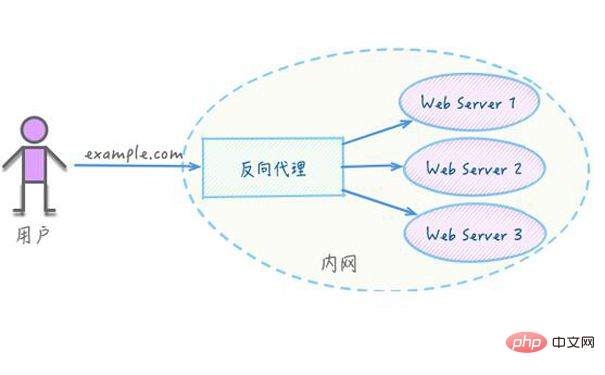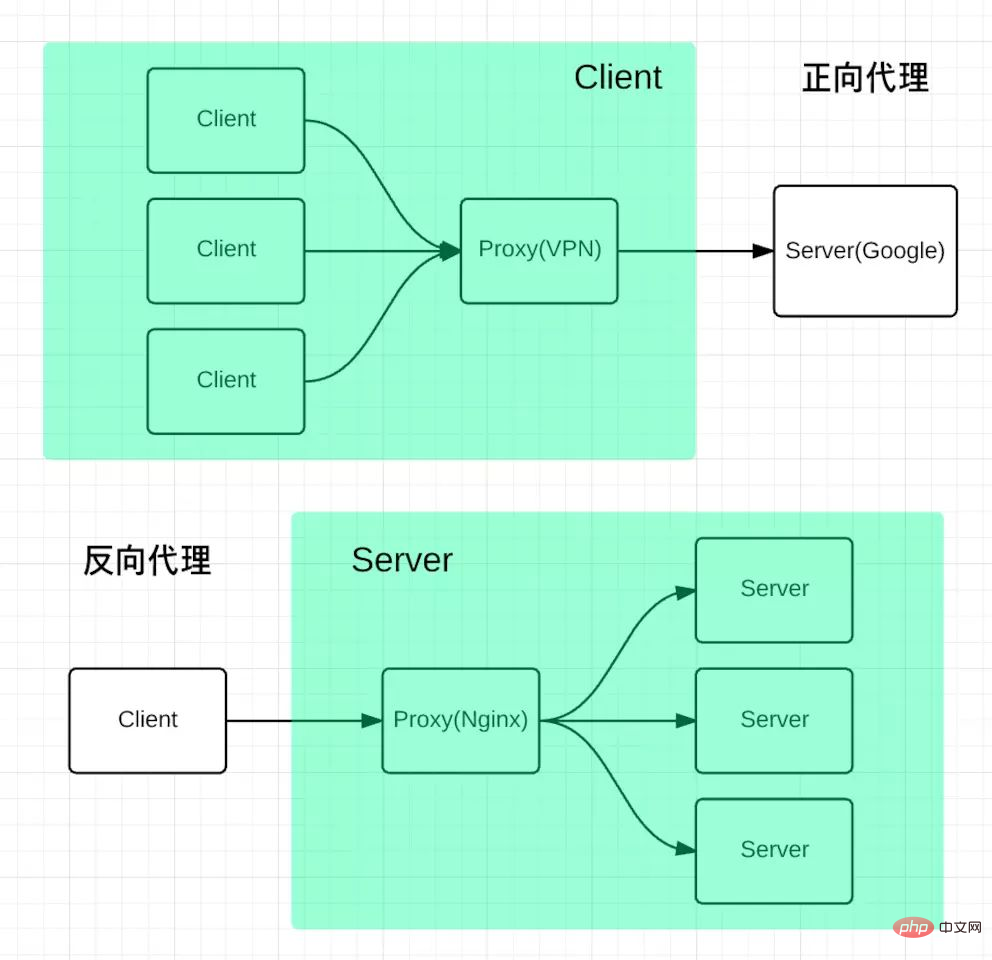
nginx 主要应用场景
1、反向代理
(推荐教程:nginx教程)
反向代理应该是Nginx做的最多的一件事了,什么是反向代理呢,以下是百度百科的说法:反向代理(Reverse Proxy)方式是指以代理服务器来接受internet上的连接请求,然后将请求转发给内部网络上的服务器,并将从服务器上得到的结果返回给internet上请求连接的客户端,此时代理服务器对外就表现为一个反向代理服务器。简单来说就是真实的服务器不能直接被外部网络访问,所以需要一台代理服务器,而代理服务器能被外部网络访问的同时又跟真实服务器在同一个网络环境,当然也可能是同一台服务器,端口不同而已。

关键命令:proxy_pass;如将 localhost 的80端口 转到 localhost 8080端口
server {
listen 80;
server_name localhost;
location / {
proxy_pass http://localhost:8080;
proxy_set_header Host $host:$server_port;
}
} 2、负载均衡
负载均衡也是Nginx常用的一个功能,简单而言就是当有2台或2台以上服务器时,根据规则随机的将请求分发到指定的服务器上处理,负载均衡配置一般都需要同时配置反向代理,通过反向代理跳转到负载均衡。而Nginx目前支持自带3种负载均衡策略,还有2种常用的第三方策略
关键命令:upstream;如将localhost 80端口的请求 均分到 localhost 8080 和 localhost 8081两个服务上
负载方案:
1)、权重 weight:必须实现session 共享,否则导致用户session不同步,导致用户重新登陆
upstream test {
server localhost:8080 weight=9; #请求的 90% 进入到8080服务器
server localhost:8081 weight=1; #请求的 10% 进入到8081服务器
}2)、ip_hash:每个请求按访问ip的hash结果分配,这样每个访客固定访问一个后端服务器,可以解决session的问题
upstream test { ip_hash;
server localhost:8080;
server localhost:8081;
}3)、fair(第三方):按后端服务器的响应时间来分配请求,响应时间短的优先分配。
upstream test { fair;
server localhost:8080;
server localhost:8081;
}4)、url_hash(第三方):问url的hash结果来分配请求,使每个url定向到同一个后端服务器,后端服务器为缓存时比较有效
upstream backend { hash $request_uri;
hash_method crc32;
server localhost:8080;
server localhost:8081;
}5)、默认:按照时间一次分配到不同的机器上
upstream test {
server localhost:8080;
server localhost:8081;
}
server {
listen 80;
server_name localhost;
client_max_body_size 1024M;
location / {
proxy_pass http://test;
proxy_set_header Host $host:$server_port;
}
}3、WEB服务器
Nginx本身也是一个静态资源的服务器,当只有静态资源的时候,就可以使用Nginx来做服务器,同时现在也很流行动静分离,就可以通过Nginx来实现,首先看看Nginx做静态资源服务器
这样如果访问 http://localhost 就会默认访问到 E://www/data目录下面的index.html,如果一个网站只是静态页面的话,那么就可以通过这种方式来实现部署
关键命令:root 当只有静态资源的时候,就可以使用Nginx来做服务器
server {
listen 80;
server_name localhost;
location / {
root e:/www/data;
index index.html;
}
}4、正向代理 不支持HTTPS
 正向代理,意思是一个位于客户端和原始服务器(origin server)之间的服务器,为了从原始服务器取得内容,客户端向代理发送一个请求并指定目标(原始服务器),然后代理向原始服务器转交请求并将获得的内容返回给客户端。客户端才能使用正向代理。当你需要把你的服务器作为代理服务器的时候,可以用Nginx来实现正向代理,但是目前Nginx有一个问题,那么就是不支持HTTPS
正向代理,意思是一个位于客户端和原始服务器(origin server)之间的服务器,为了从原始服务器取得内容,客户端向代理发送一个请求并指定目标(原始服务器),然后代理向原始服务器转交请求并将获得的内容返回给客户端。客户端才能使用正向代理。当你需要把你的服务器作为代理服务器的时候,可以用Nginx来实现正向代理,但是目前Nginx有一个问题,那么就是不支持HTTPS
5、静态分离
动静分离是让动态网站里的动态网页根据一定规则把不变的资源和经常变的资源区分开来,动静资源做好了拆分以后,我们就可以根据静态资源的特点将其做缓存操作,这就是网站静态化处理的核心思路。
upstream test{ server localhost:8080; server localhost:8081; } server { listen 80; server_name localhost; location / { root e:/wwwroot; index index.html; } # 所有静态请求都由nginx处理,存放目录为html location ~ .(gif|jpg|jpeg|png|bmp|swf|css|js)$ { root e:/wwwroot; } # 所有动态请求都转发给tomcat处理 location ~ .(do)$ { proxy_pass http://test; } error_page 500 502 503 504 /50x.html; location = /50x.html { root e:/wwwroot; } }以上就是nginx有哪些常见的应用场景的知识。速戳>>知识兔学习精品课!
